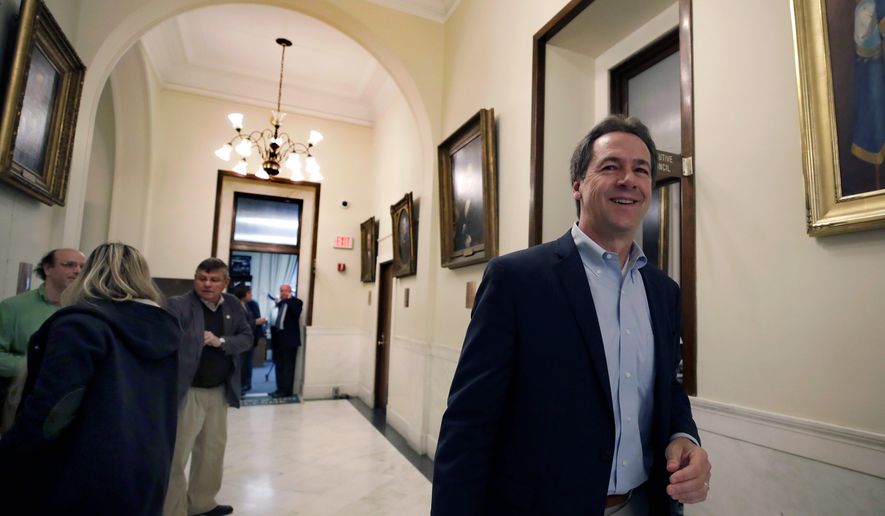While the political jockeying gets more attention, candidates in the 2020 Democratic presidential race are advancing serious policy proposals. The Washington Times takes a weekly look at some of them that may have flown under the radar.
Montana Gov. Steve Bullock released a proposal for a floating U.S. corporate tax rate that would be directly tied to how many U.S.-based jobs the companies create.
Mr. Bullock’s plan calls for an average corporate tax rate of 31%, up from the current 20%, though there would be a range of between 11% and 47% depending on companies’ investment in “American workers.”
Mr. Bullock said his plan would discourage outsourcing and would help “all Americans” reap the benefits of a growing economy.
“We should be supporting American jobs, not shipping them overseas,” he said. “In an increasingly global economy, we must pursue new ways to drive investment in American workers — that means more than returning to business as usual.”
Companies would be graded through a metric involving employment costs and revenues, and they would pay less in taxes as the ratio of wages and benefits to American employees divided by profits increased.
Calculated employment costs would only include salaries and bonuses up to $250,000 per employee “to ensure this benefits middle-class Americans,” the plan says.
His campaign estimated that total corporate tax revenue would be similar compared to the current system.
Williamson on ’Whole Health’
Author Marianne Williamson introduced what her campaign called a “Whole Health” plan aimed at cutting toxins in foods Americans consume and promoting lifestyle changes to head off health issues before they take hold.
Ms. Williamson said that the U.S. health care system puts an “unbalanced focus” on treating symptoms of illness “at the expense of treating their cause.”
“Yet until we ask why so many of us experience chronic illness, to begin with — far more than do the citizens of comparably wealthy countries — we will continue to experience unsatisfactory results in health care,” she said.
The plan calls for new research into how to cut toxins in food and curb the use of pesticides, weed killers, and antibiotics in farm animals. The plan also calls for the prevention and reversal of diseases through “lifestyle changes.”
“Addressing these factors is so essential to good health that under my plan, programs that are proven to be effective at helping people adopt these approaches will be covered as a health expense,” she said.
It would get toward universal health coverage by having everyone purchase a health insurance plan that meets certain minimum standards and can be through an employer or a public option or private nonprofit plan on a public insurance exchange.
People who decline coverage would be assessed a tax, akin to the current system under Obamacare.
Buttigieg on seniors
Mayor Pete Buttigieg of South Bend, Indiana, released a plan aimed at bolstering health care and retirement savings options for seniors that include changes to Social Security taxes for high-income earners and a new “public” 401(k) option.
His plan would not affect Social Security benefits for current recipients, but it would change the program by adding an additional tax on wages above $250,000. Currently the Social Security tax only applies to the first $133,000 a person makes.
It would also create a new “special minimum benefit” of 125% of the federal poverty line for any senior who has worked at least 30 years.
The plan says Mr. Buttigieg would work with Congress to enshrine a process of “automatically adjusting high earners’ contributions” to keep Social Security solvent.
His campaign cited an estimate from Mark Zandi, chief economist of Moody’s Analytics, that said Mr. Buttigieg’s plan would extend the solvency of the program to 2051 and reduce cumulative deficits over the next 10 years by $1.2 trillion.
The plan also includes a “public option 401(k)” that would start at larger employers. Companies would be exempt from employer contributions if they offer a defined benefit pension, a 401(k), or a similar retirement savings account.
Mr. Buttigieg would also create a special long-term care program for people over 65 who need special help for at least two activities of “daily living,” like bathing or eating, with benefits worth $90 per day.
He would expand opportunities for caregivers and increase the asset and income limits for long-term services and support through Medicaid. The plan would also implement and enforce minimum staffing ratios at long-term facilities.
Steyer on housing
Former hedge fund manager Tom Steyer released a plan intended to create 3.5 million units of affordable housing and steel cities and communities for the coming effects of climate change.
Mr. Steyer would put more than $625 billion over 10 years into existing housing programs and “mobilize” an additional $600 billion to foster “climate-smart cities” and affordable housing, according to his campaign.
“When you look at inequality in the United States of America, you have to start with housing,” he said at the last Democratic debate. “Where you put your head at night determines so many things about your life. It determines where your kids go to school, the quality of air you breathe, where you shop, how long it takes to get to work.”
He would direct $156 billion into “red-lined” neighborhoods and seek to end veteran homelessness within five years.
Mr. Steyer would also ensure that by 2030, all new residential buildings are carbon-neutral. He would retrofit all housing stock, including public housing, to be 100% carbon-neutral by 2045.
• David Sherfinski can be reached at dsherfinski@washingtontimes.com.




Please read our comment policy before commenting.